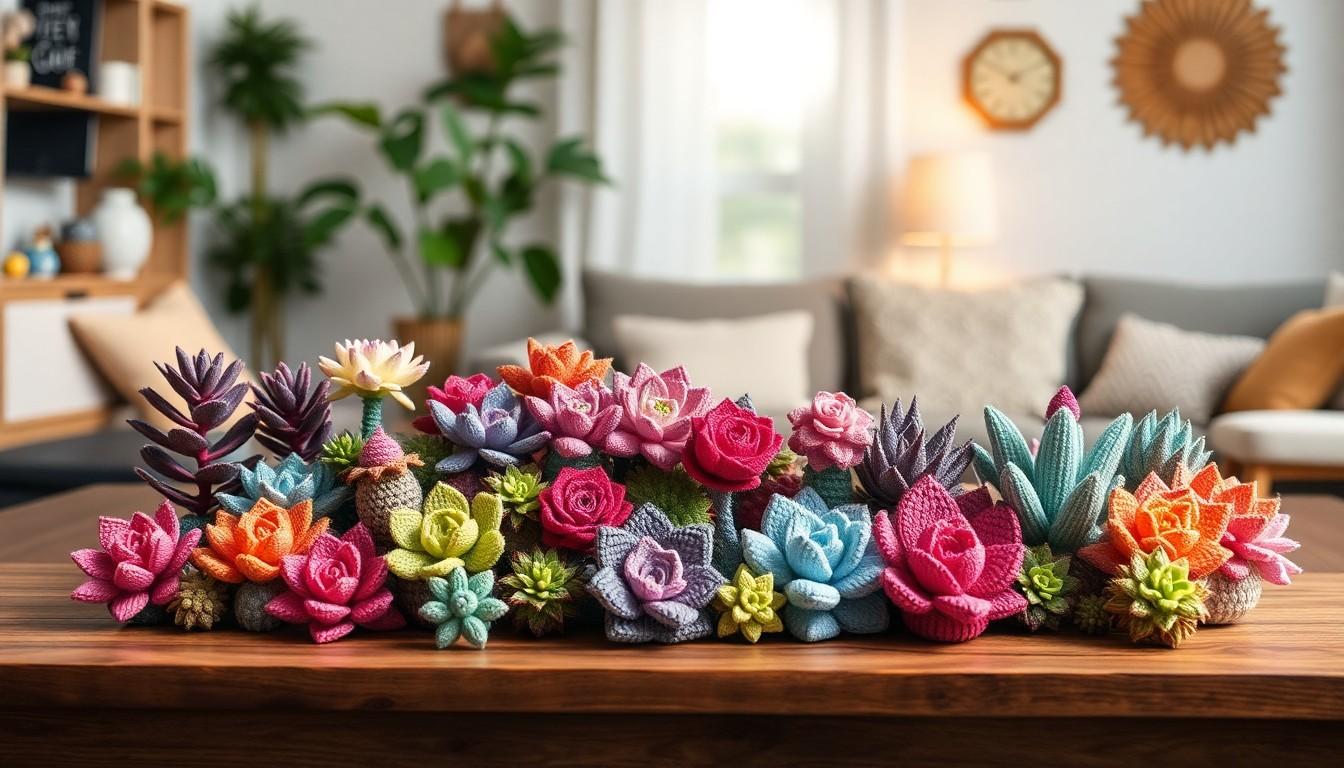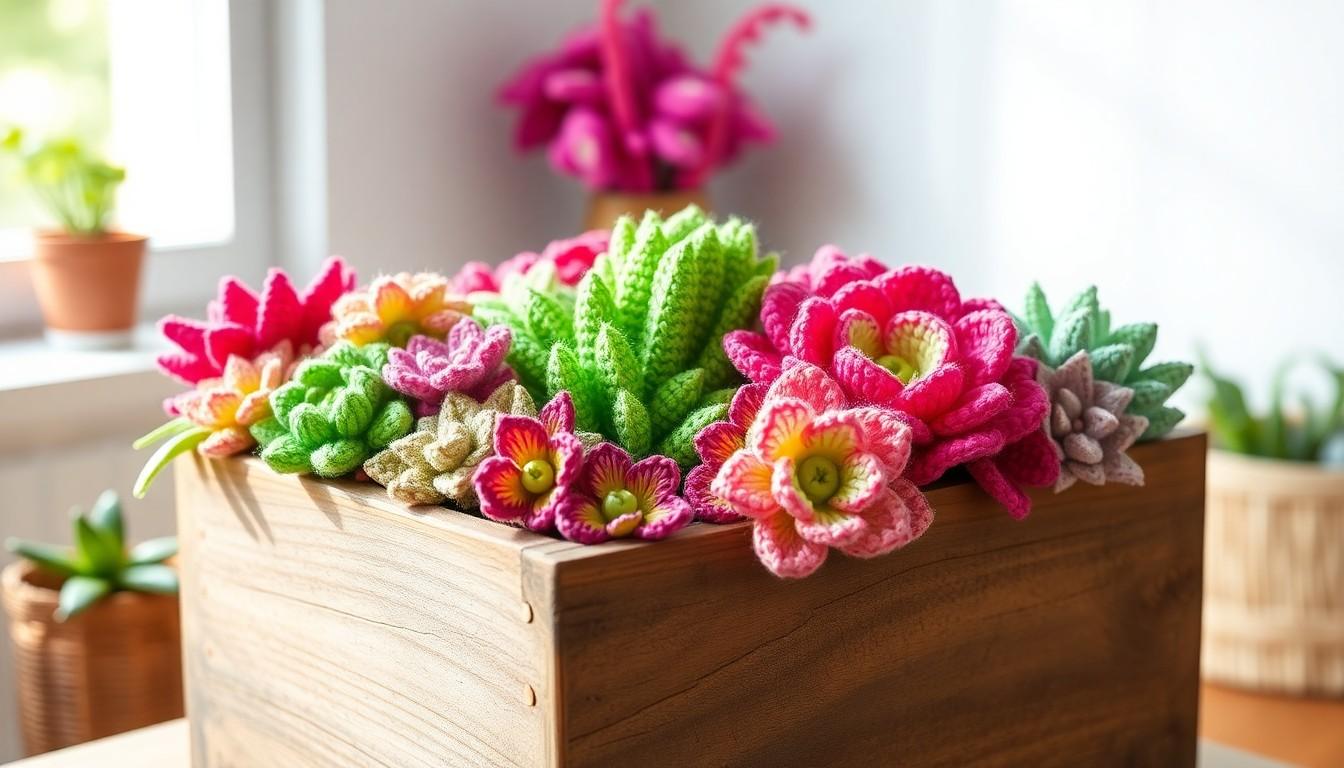Crochet succulents are taking the crafting world by storm, and it’s easy to see why. These adorable little plants never need watering, don’t mind a bit of neglect, and won’t judge you for binge-watching your favorite show instead of tending to them. Plus, they add a pop of color and whimsy to any space without the risk of a prickly encounter.
Whether you’re a crochet newbie or a seasoned pro, creating these delightful faux plants is a fun way to express creativity while enjoying the satisfaction of handmade decor. Imagine filling your home with vibrant, yarny succulents that won’t wilt or fade—just pure, guilt-free greenery! Dive into the world of crochet succulents and discover how easy it is to craft your own little garden of joy.
Overview Of Crochet Succulents
Crochet succulents represent a creative fusion of craftsmanship and decor. These handmade plants bring vibrant colors and textures into any space without the ongoing care live plants require. As low-maintenance decor items, crochet succulents attract crafters and home decorators alike.
Individuals of all skill levels find pleasure in creating crochet succulents. Beginners can start with simple patterns, while experienced enthusiasts can explore intricate designs. Various crochet patterns and stitches allow for customization, leading to unique creations that reflect personal styles.
Different types of yarn, such as cotton and wool, work well for crochet succulents. These materials offer durability and a pleasant finish. Colorful yarn selections ensure that each piece stands out, contributing to playful and artistic displays.
Crafting crochet succulents also promotes mental well-being. Engaging in the repetitive motions of crochet provides relaxation and mindfulness. This aspect enhances the enjoyment of creating art, making it a cherished hobby for many.
Versatile arrangements allow for diverse uses of crochet succulents. Individuals can incorporate them into centerpieces, decorations for special occasions, or gifts. Each succulent becomes a lasting memory, adding charm to any setting.
Communities dedicated to crochet, both online and offline, provide support and inspiration. Sharing patterns, tips, and finished projects fosters a sense of belonging among crafters. Joining these groups encourages collaboration and showcases the beauty of crochet succulents.
Benefits Of Crochet Succulents

Crochet succulents offer numerous benefits that enhance both crafting experience and home decor.
Eco-Friendly Choice
Crafting crochet succulents promotes sustainability. They eliminate the need for real plants, minimizing water usage and waste associated with live succulents. Eco-friendly materials like organic cotton or recycled yarn contribute to greener crafting practices. These faux plants last for years, reducing the frequency of replacement. Choosing vibrant yarns ensures that the aesthetics remain fresh without the carbon footprint of seasonal flowers. The ability to create unique pieces from leftover yarn scraps also prevents waste, making crochet succulents an excellent choice for environmentally conscious crafters.
Low Maintenance Appeal
Crochet succulents require minimal care, making them a hassle-free decor option. Unlike live plants, they don’t need watering or sunlight, which is ideal for individuals with busy lifestyles. People can place these crochet creations anywhere, including in low-light areas. No concern for wilting or pests exists, allowing for worry-free enjoyment. Decorative possibilities are endless, from desks to living areas. Their durability ensures that they maintain their vibrant colors and shapes over time. Choices in design mean every crocheted succulent can suit different tastes, adding charm without the upkeep.
Materials Needed For Crochet Succulents
Creating crochet succulents requires specific materials to ensure the final product is both beautiful and durable. The right yarn and tools contribute significantly to the crafting experience.
Yarn Types
Cotton yarn stands out as a popular choice for crochet succulents due to its durability and vibrant color options. Wool yarn also adds warmth and texture, though it may not be as colorfast. Blends that incorporate acrylic can offer additional strength and resistance to wear. For those seeking eco-friendly options, recycled yarn creates an appealing sustainable approach. Experienced crafters often mix different yarn types to enhance visual interest. Selecting yarn that maintains shape and resists fraying ensures the succulents look great for years.
Tools Required
Several essential tools streamline the process of creating crochet succulents. A crochet hook is indispensable; typical sizes range from 2.5 mm to 5 mm depending on yarn thickness. Scissors become necessary for trimming stray yarn ends after crafting. Stitch markers help crafters keep track of their progress and ensure accurate stitch counts. Additionally, a yarn needle is useful for weaving in loose ends and finishing touches. Crafting mats or flat surfaces can further enhance the workspace, ensuring comfort and focus. Having these tools organized enables efficient crafting sessions.
Basic Techniques For Creating Crochet Succulents
Crochet succulents require specific techniques to achieve desired shapes and textures. Mastering these methods enhances the overall crafting experience.
Stitch Patterns
Utilizing various stitch patterns creates distinct looks for crochet succulents. Single crochet offers a tight and firm structure, while double crochet adds height and openness. Shell stitches provide a decorative touch, mimicking the natural curvature of succulent leaves. Incorporating puff stitches introduces a fun, textured element, enhancing the visual appeal. Experimenting with these patterns allows for creativity and personalization in each project. Following a chosen pattern can guide crafters in developing unique designs for their succulents.
Assembly Tips
Assembling crochet succulents involves combining individual parts effectively. Begin by using a tapestry needle to stitch each piece together securely. Positioning the leaves in a natural arrangement contributes to a realistic appearance. Choose a weighted base, such as a small pot filled with stones or sand, to stabilize the succulent. Gluing leaves or flowers in place offers additional support and permanence. Finally, adding embellishments, like small rocks or faux soil, creates an authentic look. Utilizing these assembly tips ensures a well-crafted final product that captivates attention.
Popular Crochet Succulent Patterns
Numerous crochet succulent patterns cater to various skill levels, making them accessible and enjoyable for crafters. Popular choices include the classic crochet cactus, featuring distinct shapes and vibrant colors. Patterns for succulents like the Echeveria and Aloe Vera showcase unique leaf structures and textures, appealing to those seeking realism in their creations.
Variations like the crochet rosette provide versatility in design, letting artisans experiment with different yarn types and color combinations. Each pattern allows for playful adaptations, such as incorporating embellishments like beads or using various stitch techniques to enhance visual interest.
The crochet succulent set is particularly sought after, combining multiple types, such as the jade plant and barrel cactus. This grouping encourages creativity, as crafters can create a mini garden display or craft individual pieces to share as gifts.
Instructions for popular patterns often outline skill levels, from beginner to advanced, ensuring crafters select projects that align with their experience. For instance, simple patterns like the crochet succulent ball engage beginners while introducing them to more complex tasks as their skills progress.
Online platforms and communities share free patterns and tutorials, supporting crafters in their journey. Crafters frequently modify existing patterns, personalizing them to reflect their unique styles. With a wealth of resources available, exploring various crochet succulent patterns enhances the crafting experience, encouraging experimentation and creativity.
Using an array of yarn types, such as cotton or recycled yarn, enriches texture and durability in each piece. Engaging in this craft fosters both creativity and a sense of achievement, leading to stunning decorative displays that never wilt.
Conclusion
Crochet succulents offer a delightful blend of creativity and sustainability. They bring color and charm to any space without the upkeep of live plants. This craft not only enhances home decor but also promotes mental well-being through the joy of making.
With endless patterns and materials available, crafters can personalize their creations to suit their style. The supportive crochet community fosters collaboration and inspiration, making it easy for anyone to dive into this rewarding hobby.
As they explore the world of crochet succulents, individuals can enjoy a fulfilling experience that brightens their homes while being eco-friendly. It’s a perfect way to express creativity and embrace a low-maintenance lifestyle.

